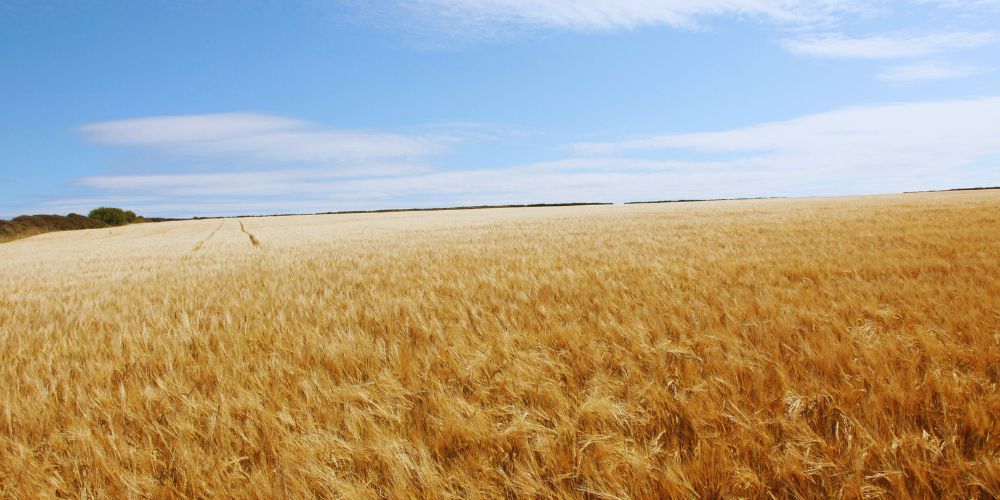The territory in which Monte Giberto is located, the so-called Marca Fermana, is characterized by sea, hills and mountains. This variety of landscapes and climates makes it unique and fertile.
The link between cuisine and territory is powerful. Fermana gastronomy offers many typical products and dishes linked to peasant and maritime traditions.
In particular, in Monte Giberto, an ancient grain is cultivated. It's jervicella wheat, a wheat that, for its properties, has become a gastronomic excellence.
In this article, we will discuss the history, characteristics, culinary products, and specialities made with this wheat!

The history of jervicella wheat, the wheat of Monte Giberto

The cultivation of Jervicella wheat in Fermo and Ascoli Piceno territories has been documented since the early 1800s.
Specifically, in 1811, at the request of Filippo Re, Giovanni Brignoli, a professor of botany and agriculture in Urbino, compiled a list of wheat varieties grown in the Marche region.
At the same time, Filippo Re coordinated research to gather information on the agricultural progress and traditions of the areas of the Kingdom of Italy.
The results of this research, published in the Annals of Agriculture of the Kingdom of Italy, confirmed the presence of wheat identified with Jervicella in the Marche territory by colour and size.
Another important written source from 1884, relating to agriculture and farmers' working conditions, reveals valuable information on the location of Jervicella wheat crops and their use for the production of straw hats.
In addition to the written sources, we have the testimony of Giulia Jervicella, daughter of Giuseppe Jervicella. Giuseppe was a citizen of Monte Giberto and was identified as the creator of this wheat variety.
Giulia recounts that in the 1940s, during Fascism, her father began to select and cultivate Jervicella wheat in a field on the family estate in Monte Giberto.
Jervicella then quickly spread throughout the Marche countryside.
Jervicella wheat was also recognized and registered in the National Grain Register of the “Nazareno Stampelli” Institute of Genetics in Rome.
After the war, from the 1950s onwards, the situation changed as the production of this wheat decreased more and more because many farmers left the countryside in search of less hard work in the cities on the Adriatic coast.
The reduction in the production of Jervicella wheat is also linked to its very characteristics.
It is a wheat that can grow very high, and consequently, when exposed to the weather, it quickly spoils and bends to the ground.
Furthermore, Jervicella is a grain that produces only tiny quantities. Therefore, many farmers decided to cultivate other, lower and more productive grains.
The few farmers who remained in Monte Giberto partly continued cultivating this grain, preserving an ancient tradition and allowing us to continue to have genuine products on our tables.
The origin of the name

There are two theses for the origin of the name Jervicella.
According to the first theory, Jervicella would derive from the word “jerva” (grass) in Picenum dialects.
The diminutive Jervicella (short grass) would be related to a particular characteristic of this grain. When Jervicella is planted in spring, at harvest time, it is lower than grain sown in autumn.
The other theory, strongly supported by the Jervicella family, claims that the name comes from the creator of this type of wheat: Giuseppe Jervicella.
Characteristics of Jervicella wheat

Jervicella wheat is an original native wheat. Unlike many grains used in recent years, it is not contaminated or genetically modified. A fundamental characteristic of this wheat is its high digestibility.
It also has excellent nutritional characteristics. It is low in gluten and high in fibre. It is a source of protein and is recommended in low-calorie diets because of its low glycemic content.
Bread, pasta and desserts made with Jervicella wheat

In Monte Giberto, you can taste excellent pasta, bread, and tasty desserts made with Jervicella wheat.
Jervicella wheat flour is rich in fibre and protein and contains little sugar and carbohydrates.
Bread made from Jervicella wheat flour is recommended for a balanced daily diet.
It is rustic, tasty, rich in nutrients and low in gluten.
We have Jervicella crackers, focaccia, and the so-called “scrocchiarella", a crispy, thin pizza as an alternative to classic bread.
With Jervicella flour, we can bake tasty desserts such as doughnuts, dry anise cookies, and even maritozzi (a sweet bun with whipped cream) with cranberries.
Finally, pasta lovers will enjoy pasta made with Jervicella wheat flour, Jervicella wheat semolina pasta and tortellini.
A typical dish we recommend is tagliatelle Jervicella with stewed meat sauce.
You can taste typical local dishes and products during one of the many festivals and eno-gastronomic events held throughout the year in Monte Giberto.
Among the most famous festivals, we name the Tagliatella festival (festa della Tagliatella), held in April, and the Autumn festival (festa d'Autunno) in October.
Jervicella wheat for straw hat production
Peasant culture teaches us to use all that nature offers without wasting.
Jervicella wheat, thanks to its long stem, is also used to produce traditional straw hats.
In the past, farmers used a practical and cool straw hat when they reaped wheat.
In the province of Fermo, straw hat production developed in Montappone, Massa Fermana, Monte Vidon Corrado, and Falerone, especially during the 19th century.
Montappone is considered the capital of the “hat district”. Here, you can visit the fascinating Hat Museum, which uses various materials to show how straw hats are made from Jervicella wheat.
About the author
Written on 29/10/2024



Ilaria Capatti
The history and characteristics of jervicella wheat, gastronomic excellence of Monte Giberto.